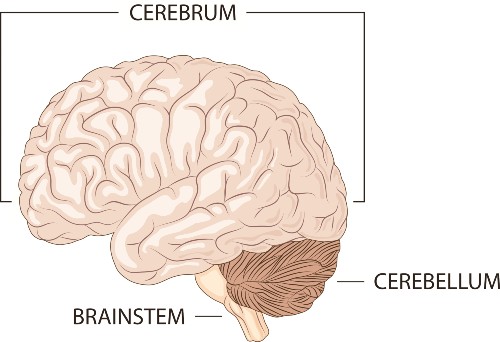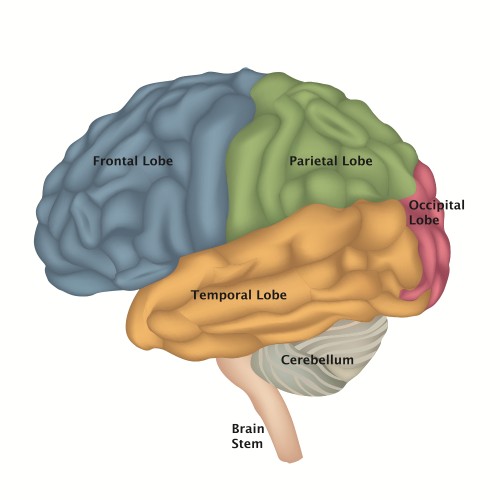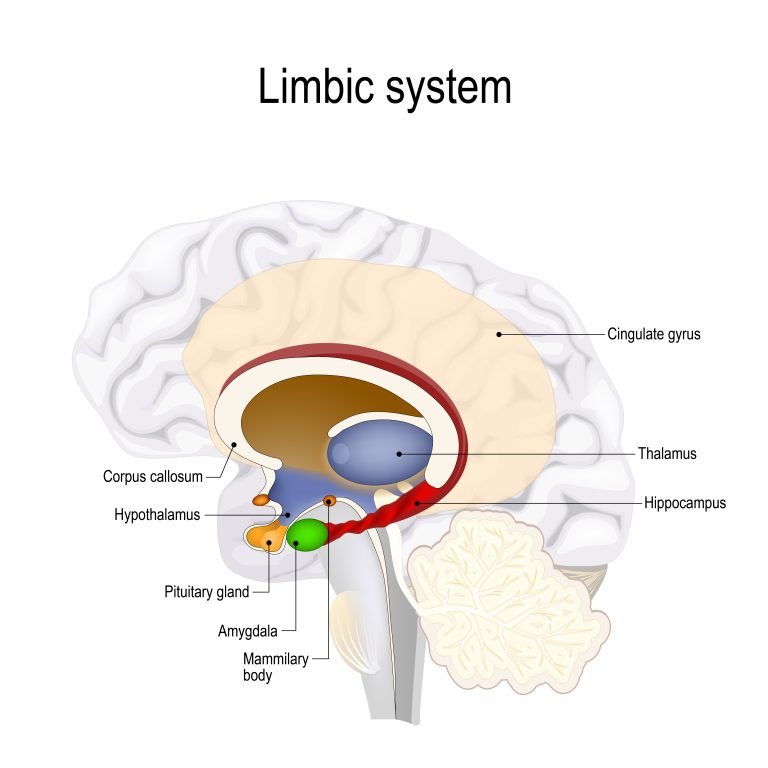Everything starts in the brain. You take a breath, you feel hungry, you go to sleep – your brain controls it all.
Each part of your brain has different responsibilities. If a certain part of your brain is injured, it may not be able to perform its responsibilities the same way it did before – or at all. Learning about each part of your brain and what it controls can help you understand why you may be experiencing certain effects from your brain injury.
Let’s talk about:
- The three main parts of your brain and what they do
Your brain is divided into three main parts:
- The cerebrum
- The cerebellum
- The brainstem

The cerebrum
The cerebrum is the front of your brain, and the largest part. Your cerebrum is covered by a grey matter called the cerebral cortex, which gives your brain a wrinkled look. Each fold in the grey matter is called a gyrus, and each valley between the folds is called a sulcus. These folds and valleys increase the number of neurons in the brain, which help us operate.
The cerebrum is divided into two hemispheres – the left hemisphere and the right hemisphere. The left hemisphere controls the right side of your body, and the right hemisphere controls the left side of the body.
Among other things, the left hemisphere is responsible for:
- Speaking
- Listening
- Reading
- Writing
The right hemisphere is responsible for things like:
- Following directions
- Solving puzzles
- Drawing
- Recognizing objects/people
The four lobes of your brain
Within your cerebrum and the two hemispheres, there are four lobes that also control different functions.

Frontal Lobes
The frontal lobe is the decision-making centre of your brain (also called the executive function centre). It receives information from the other lobes and figures out the best way to respond to your environment. The frontal lobe controls things like:
- Memory
- Concentration
- Judgement and inhibition
- Movement
- Smell
- Taste
- Self-awareness
- Personality traits
- Organization
- Word formation
Damage to your frontal lobes may lead to problems with emotional control, social skills, judgment, planning, and organization. Damage to your left frontal lobe may cause problems with speech and moving your right arm or leg, while damage to your right frontal lobe may cause problems moving your left arm or leg.
Parietal lobes
The parietal lobes are responsible for sending and receiving visual, auditory, and touch information. Anything you see, hear, or physically feel is processed in this part of the brain. The left parietal lobe is responsible for recognizing speech and words. The right parietal lobe is responsible for understanding where objects are around you. For example, “this book is next to my right hand” or “there is a post on the left that I need to walk around.”
Damage to the left parietal lobe may lead to problems with reading and math and could cause a loss of sensation on the right side of your body. This means that you could have changes in how you feel touch or pain, vision, or temperature changes on your right side.
Damage to your right parietal lobe may lead to problems with spatial tasks, like making sense out of pictures, diagrams, reading maps, and where objects are around you. Damage may also cause changes in sensation on the left side of your body.
Temporal lobes
Temporal lobes are responsible for distinguishing smells and sounds. They also complete the following jobs:
- Acquiring and storing memories
- Perception
- Categorization of objects
The left temporal lobe is responsible for your language comprehension through listening and reading, while the right temporal lobe helps you understand non-verbal sounds (like a car horn) and music.
Damage to the left temporal lobe may cause problems in understanding and remembering language.
Damage to the right temporal lobe may cause problems in understanding and remembering non-verbal information such as pictures, diagrams, body language cues, and other visual messages.
Occipital lobes
Occipital lobes process visual information like patterns and colours. This helps you identify objects and signals.
Damage to the left occipital lobe may cause problems seeing things on your right side and damage to the right occipital lobe may cause problems seeing things on your left side.
The limbic system
Within your brain there are structures that control even more specific functions than your four lobes.

These structures include:
The corpus callosum is a portion of white matter that allows the two hemispheres of the brain to communicate.
Any damage to the corpus callosum can cause issues with that communication between the hemispheres leading to a variety of challenges.
The hypothalamus is a small section at the base of your brain that controls the nervous system through hormone production and release. It is responsible for regulating things like:
- Hunger
- Thirst
- Blood pressure
- The sleep/wake cycle
- Sexual arousal
Damage to your hypothalamus can result in a lack of motivation, changes in thirst/hunger routines, feelings of euphoria, hyperactivity, or altered sleep patterns.
The pituitary gland is located beneath the brain. It dispels hormones to regulate bodily functions like blood pressure.
Damage to the pituitary gland can result in fluctuations in hormone development that impact bodily functions.
The amygdala processes feelings like love, aggression and fear, and the responses of your body when you experience those feelings. It also helps you recognize those emotions in other people.
Damage to the amygdala can cause both cognitive and emotional challenges, including decision-making impairments.
There are two mammillary bodies, and they help pass information to other parts of your brain that are in charge of creating memories.
Damage to the mammillary bodies may impact the ability to retain memories.
The hippocampus is responsible for creating long-term memory.
Any damage to this area of your brain would result in difficulty or the inability to create memories.
The thalamus is the central relay station for incoming sensory information. Every sensation you experience travels through the thalamus. It plays an important part in pain information, memory, alertness, and attention span.
Damage to your thalamus can result in many symptoms, including trouble processing information or forgetting to complete a part of a task that corresponds to the opposite side your injury is on. For example, if your injury is on the right side of your brain, you might forget to eat food on the left side of your plate, or brush your hair on the left side.
The cingulate gyrus controls your autonomic functions like heart rate regulation, and it also processes your emotions and regulates your body’s response to emotions.
Damage to your cingulate gyrus can alter your emotions. For example. you might experience more aggressive behaviour or shyness.
There are other parts of your cerebrum that we haven’t included here. But if you would like to dive into more detail, you can start with some of these resources
The cerebellum
The cerebellum is at the back of your brain and is mainly associated with movement including:
- Balance
- Coordination
- Posture
- Speech
It also stores memories of your practiced movements like riding or bike or playing an instrument. Lastly, it supports cognitive functions like language and your mood.
What happens if your cerebellum is damaged?
Damage to the cerebellum may cause problems with coordination, balance, or muscle tone in different parts of the body.
The brainstem
Your brainstem connects your brain to your spinal cord, and relays information back and forth from your brain to your peripheral nervous systems. Your brainstem controls basic life functions, including:
- Breathing
- Blood pressure
- Heart rate
- Sweating
- Digestion
- Alertness
There are three main parts of your brainstem and they are:
- The midbrain
- Pons
- Medulla oblongata
Midbrain
The midbrain is responsible for auditory and visual reflexes. It controls your eye movements, processes sight and sounds, and how your eyes and ears react to the environment.
Pons
Pons is the largest part of your brainstem. It acts as a bridge between the cerebrum and cerebellum. The pons controls various parts of your body, including facial nerves and movements. One of its most important roles is as a respiratory information centre. The pons controls breathing, including information on carbon dioxide and oxygen levels.
Medulla oblongata
The medulla oblongata also helps control respiration through controlling the heart and lungs. It is responsible for blood vessel actions, cardiac functions, and reflex actions like sneezing or coughing.
What happens if your brainstem is damaged?
Any damage to your brainstem can cause physical and sensory problems like:
- Stopping or disrupting your heartbeat or breathing
- Swelling leading to hemorrhaging and stroke
- Speech impairment
- Difficulty swallowing
- Personality changes
- Memory loss
In the most severe cases, damage to the brainstem can lead to coma or paralysis.
This only skims the surface of how the brain works. If you have specific questions, ask your doctor to connect you to a neuropsychologist. They’ll be able to provide you with more details.
Disclaimer: There is no shortage of web-based online medical diagnostic tools, self-help or support groups, or sites that make unsubstantiated claims around diagnosis, treatment and recovery. Please note these sources may not be evidence-based, regulated or moderated properly and it is encouraged individuals seek advice and recommendations regarding diagnosis, treatment and symptom management from a regulated healthcare professional such as a physician or nurse practitioner. Individuals should be cautioned about sites that make any of the following statements or claims that:
- The product or service promises a quick fix
- Sound too good to be true
- Are dramatic or sweeping and are not supported by reputable medical and scientific organizations.
- Use of terminology such as “research is currently underway” or “preliminary research results” which indicate there is no current research.
- The results or recommendations of product or treatment are based on a single or small number of case studies and has not been peer-reviewed by external experts
- Use of testimonials from celebrities or previous clients/patients that are anecdotal and not evidence-based
Always proceed with caution and with the advice of your medical team.
Information for this page provided in part by Ontario Brain Injury Association and My Health Alberta. Originally sourced from braininjurycanada.ca